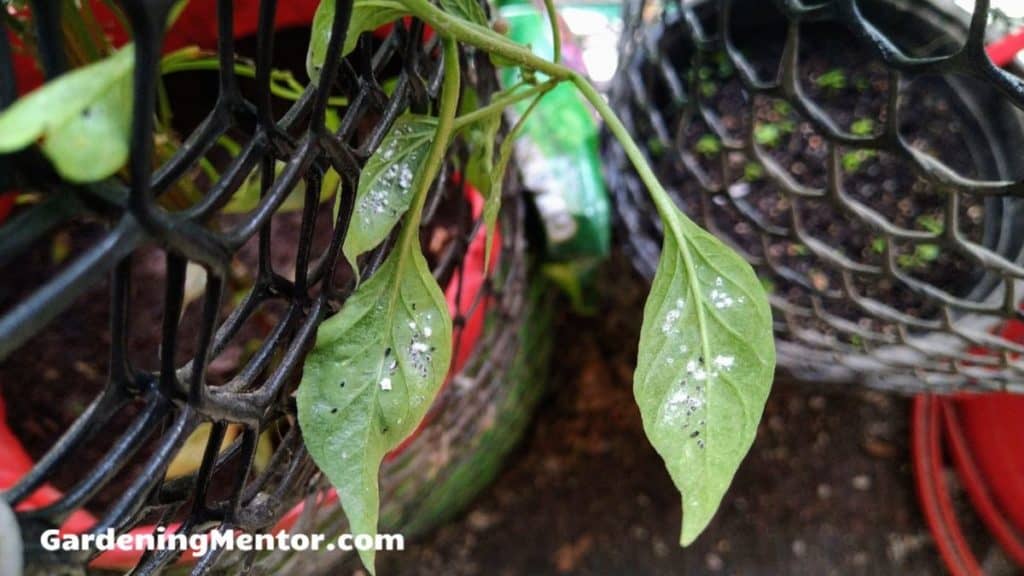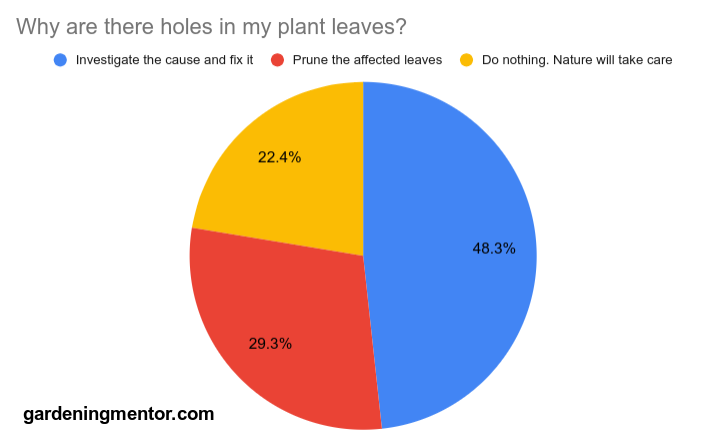It’s not funny.
You look at your plant and find holes in the leaves. What could be doing those, you wonder?
Your plant leaves have holes because some pest is eating the leaves. You need to monitor the plant to check for any insects eating the leaves. The plant leaves can get holes from disease or improper use of chemical sprays on the plant.
I’ll give you more details on why there are holes in the plant leaves and how to improve the situation. I’ll also help you find out how to avoid these problems in the first place.
So keep reading.
Why Are There Holes In My Plant Leaves?
The most common reason there is a plant with holes in leaves is pests eating them. However, this cannot be said for all plants because most pest attacks are specific to certain plant families or species within that family. Some other causes are diseases, herbicides, weather, and even pets.
If your plant has lots of leaves and a few of them have holes, it’s not a problem. They will be just fine.
If you’re growing your vegetables, it may be a little off-putting to eat them when the leaves have holes. But it’s not harmful to do so as long as you get rid of pests or diseases on them.
If you’re growing plants for ornamental purposes, it may seem a little sad to see holes in the leaves. But if there are just a few you could get rid of them or hide them.
Below are some of the causes of holes in your plant leaves.
1. Caterpillars
Caterpillars are a common pest that will eat the plant leaves and make holes in them. They can be hard to see because they camouflage so well with the leaves.
They typically eat the outside of leaves, but in the case of some plants, they eat the leaves from the inside out, making it more difficult to control.
Check on your plant leaves every day for caterpillars. It’s best to pick them up as soon as they are on the plant. You can drop them in a bucket of soapy water.
If you’re squeamish about picking them off the plant, you can spray the leaves with Bacillus thuringiensis (Bt) to get rid of them.
2. Natural holes
Some plants have natural holes in them, such as the Swiss cheese plant from the Aroid family. But the holes and slots are outlined nicely, making them look beautiful rather than pest-ridden.
Nothing to do here than admire the beauty of the plant and the natural holes that the leaves have in them.
3. Herbicides
This is not a common cause of holes in plant leaves. But it can happen if you’re not careful with using herbicides.
The strong chemicals can affect the leaves causing them to burn. I don’t recommend using chemicals on your plants. Use an organic alternative that is much better.
Even if you have to use a herbicide, make sure to test it out on a few leaves first. Leave it for a day and check if there has been a reaction.
4. Slugs And Snails
Snails and slugs can be a common cause of eating up your plant leaves. They tend to come out at night so you can check your plant leaves with a flashlight.
When you see irregular open holes with smooth edges, that’s a good indication that slugs and snails are eating your plant.
You can pick slugs and snails from the plant and drop them in a bucket of soapy water. The only problem is you need to do this at night when they are active.
The other option is to set up a beer trap near the plants. You dig a shallow hole and put a deep container filled with beer in it. Make sure the mouth of the container is aligned with the top of the soil.
The snails and slugs are attracted to the beer and fall into the container where they drown. Make sure to empty the container filled with these pests in the morning and set up a new batch.
5. Sawfly larvae
This kind of larvae eats the leaf of plants from its edge to its tissue, leaving only the veins intact. Quite a look-alike of caterpillars, sawfly larvae seem tiny but come with an enormous appetite and can eat your plant’s leaves in no time.
I like neem oil as a method to get rid of sawfly eggs and larvae. The best time to spray it is in the morning or evening when the sun is not out.
You need to dilute the neem oil or it will burn the leaves. Follow the instructions on the bottle. Typically, you put 2-5 ml per 1 liter (33 ounces) of water.
Add 2-3 drops of dishwashing soap and shake the mix well. This helps the oil and water to mix and form an emulsion.
Spray this on all the leaves of the plant. Make sure to spray on the bottom of the leaves where most of the eggs and larvae will reside.
How Do You Prevent Holes In Plant Leaves?
The best way to protect your leaves is to prevent the holes in the first place. I recommend checking on your plant leaves every day as part of your routine.
If you find pests, diseases attacking the plant you can take care of them as soon as possible and prevent more significant problems.
If you see pests like caterpillars, slugs, snails on the plant, it’s best to pick them by hand and dump them in a bucket of water.

If there are sap-sucking pests like aphids, whiteflies, or mealybugs, you can spray water on the leaves and dislodge them onto the soil.
For other pests like sawfiles, you can spray neem oil or horticultural oil to eliminate their eggs and larvae.
I like to spray neem oil solution every week on my plant leaves as a precaution to keep as many pests away from my plant leaves.
48% of my fellow gardeners feel it’s best to find out the cause of the holes in the plant leaves and fix it.

I also like to add compost or cow manure every 15 days to my plants to ensure they get the right nutrients and remain in good health. This helps them remain strong and fight against pests and diseases.
To protect your plants from pets, birds, and animals, you can enclose the plant in a cage or netting. Make sure to use material that has enough breathing space for the plant size.
How Do You Control Leaf-eating Insects?
There are different leaf-eating insects, so you first need to figure out which one is attacking your plant. Some such insects include caterpillars, sawflies, slugs, and snails.
I think the best solution is to pick these insects off the plant and dump them in a bucket of soapy water. It is the most effective solution as you ensure you get all of them.
If you’re not comfortable picking these insects, you can try alternatives such as spraying Bacillus thuringiensis, neem oil, or horticultural oil.
You can even set up traps for the insects using sticky traps for caterpillars, sawflies, or beer traps for slugs and snails.
I like to spray neem oil emulsion every week all over the leaves of my plants as a precaution to keep pests away from my plants.
Read more:
How Do You Control Animals And Birds Eating The Leaves?
I like to have birds and pets around my plants. They make the place lively and protect plants from some of the pests.
However, sometimes they can chew on the leaves for food or play and damage them.
I don’t like to use chemicals that can harm these creatures. Instead, enclosing the plants in a cage is an excellent solution to keep them away from the leaves.
I make my own cage using sturdy plastic netting to enclose house balconies and prevent birds from entering. This material is sturdy plastic that can stay straight and won’t get easily damaged.
What Deficiency Causes Holes In Leaves?
Potassium deficiency can cause holes in leaves. The lack of this nutrient will cause yellowing in the leaf which may develop into holes. If you find holes in leaves but no bugs, chances are it’s due to a deficiency or disease.
I recommend adding compost or balanced organic fertilizer every 15-30 days to your plant soil. This helps the plant get the required nutrients including potassium.
You can spray banana tea on the leaves to ensure they get a good dose of potassium. To make this tea you can cut up banana peels and put them in a container together with some jaggery and little yeast.
This mixture needs to be kept in a cool, dark place for about three months, and you’ll get a jelly-like nutrient mix. Take a little of this and mix with water. Spray this solution on the leaves every 15 days to give them a good dose of potassium.
What Disease Causes Holes In Plant Leaves?
Shot hole disease or Coryneum blight is one that will cause holes in plant leaves. This fungal disease creates holes in leaves, fruits, rough areas on fruit, and lesions on branches.
The fungus spreads through spores that float in air currents. These spores land on the surface of the plant where it grows rapidly causing spots on the leaves.
It’s important to remove infected parts immediately because the infection could spread throughout the entire plant. if left untreated
In order to control this problem, you should wash the affected area thoroughly with soap and water. Then apply fungicide sprays containing copper sulfate or sulfur.
In order to avoid getting infected by this disease, you should take preventive measures. Like other fungal issues, the cause is humid conditions near the plant.
You should avoid overwatering the plant and prevent splashing water on the leaves. Ensure good air circulation among the leaves and prune any leaves that are blocking airflow.
Should You Remove Leaves With Holes?
You should remove leaves with holes if they are caused due to a disease. This will help prevent spread of the disease if it’s a fungal problem. You can also remove leaves with holes if you are growing the plant for aesthetic appeal. You should remove leaves with holes if the major portion of the leaf is damaged.
If you find a plant with holes in leaves but the holes are small and not diseased, it’s OK to keep the leaves as there won’t be a problem in their growth or any harm to the plant.
Is It Safe To Eat Leafy Greens With Holes?
I like to grow vegetables in my container garden. If you do the same you may find holes in leafy greens or herbs like basil.
It’s safe to eat leafy greens with holes if pests or animals create them. You need to wash them well before eating. If the disease has caused the holes, I would not recommend eating them.
You can do the same with herbs such as basil that may have holes in the leaves due to pests. Wash the leaves well and they are fine to consume. If you figure the holes are due to a disease, avoid using that basil.
Read more:

Fact Checked, Written, and Published by Kevin Rodrigues
Kevin is the founder of Gardening Mentor, a website that aims to teach people to grow their own food in a limited space. As a self-taught gardener, Kevin has spent several years growing plants and creating gardening content on the website. He is certified in Home Horticulture and Organic Gardening from Oregon State University. He has a Post Graduate Diploma in Horticulture and Landscape Gardening from Mumbai University.
Read more
